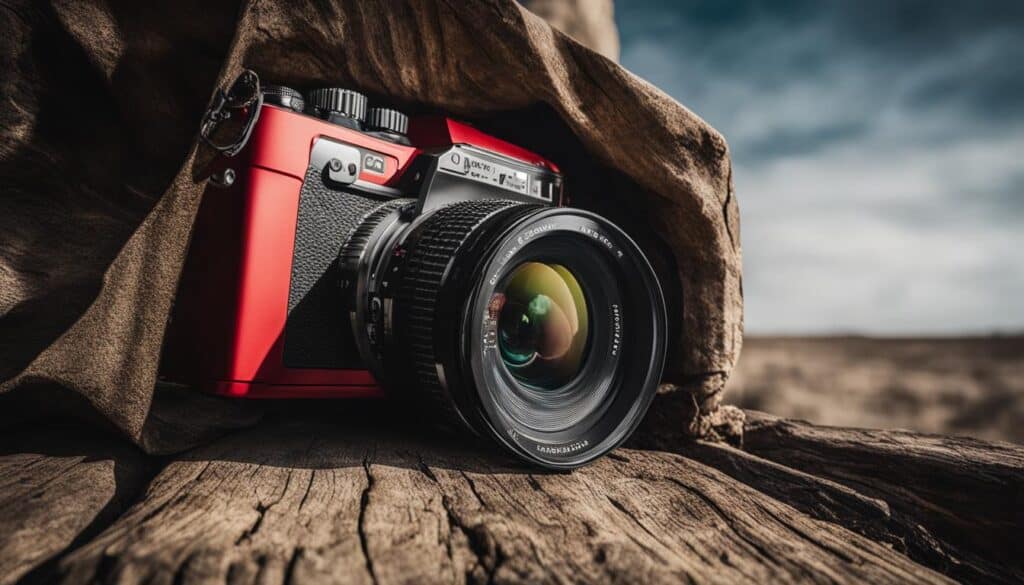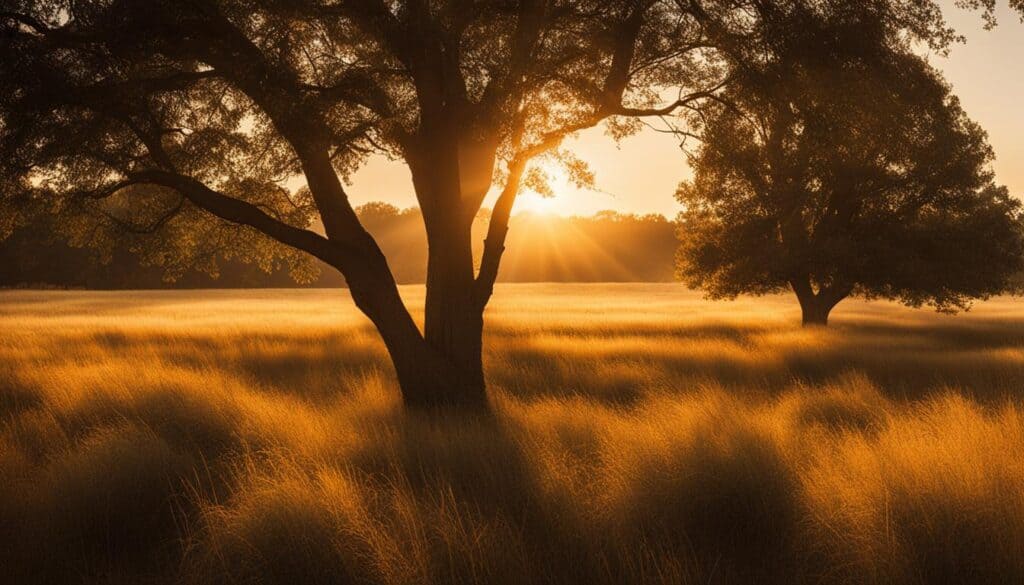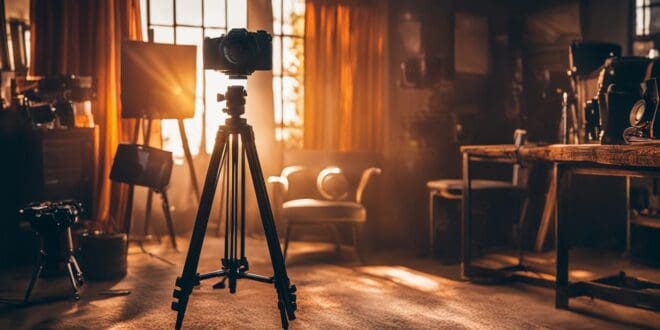Welcome to the world of photography! If you’re a beginner looking to enhance your skills and capture stunning images, you’ve come to the right place. Whether you’re using a smartphone or a DSLR camera, these top photography tips will help you unleash your creativity and take your photos to the next level. From basic camera use to creative photo ideas, we’ve got you covered.
Key Takeaways:
- Master the basic camera settings like exposure, aperture, shutter speed, and ISO.
- Experiment with different perspectives and angles to add interest to your photos.
- Utilize natural light, such as the golden hour, to enhance your subject.
- Learn composition techniques like the rule of thirds and leading lines to create visually pleasing images.
- Join a photography community to learn, grow, and receive constructive feedback on your work.
Choose the Right Equipment

Before you start your photography journey, it’s important to choose the right equipment that suits your needs and budget. The type of camera and lenses you use can greatly impact the quality of your photos.
Investing in a camera that matches your skill level and preferences is crucial. Consider whether you want a DSLR (Digital Single-Lens Reflex) or a mirrorless camera. DSLRs offer versatility and a wide range of lens options, while mirrorless cameras are compact and lightweight, perfect for travel photography.
When it comes to lenses, think about the type of photography you want to pursue. If you’re interested in landscapes or architecture, a wide-angle lens can capture the expansive views. For portraits, a telephoto lens can create stunning bokeh and allow you to get closer to your subject. And if you’re unsure, a versatile zoom lens can cover a variety of focal lengths.
Top Tips for Choosing Camera Equipment:
- Research different camera models and brands to find the one that suits you best.
- Consider the weight and size of the camera, especially if you plan on carrying it for long periods.
- Read reviews and compare features to ensure you’re making an informed decision.
- Visit a camera store and try out different models to see how they feel in your hands.
- Invest in quality lenses that match your photography interests and goals.
Remember, the right equipment is a tool that helps bring your creative vision to life. Choose wisely and embark on your photography journey with confidence.
Understand Camera Settings

Understanding camera settings is essential for capturing the perfect shot. Whether you’re a beginner or an experienced photographer, getting familiar with your camera’s settings will allow you to have full control over your images.
One of the key camera settings to understand is exposure. Exposure refers to the amount of light that enters the camera and determines how light or dark your image will be. By adjusting the exposure, you can create both bright and airy or dark and moody photos.
Aperture, also known as the f-stop, is another important setting. It controls the depth of field in your photos, determining how much of the image is in focus. A lower aperture, such as f/1.8, will create a shallow depth of field with a blurred background, while a higher aperture, like f/16, will result in a greater depth of field with more of the image in focus.
Shutter speed is the next setting to understand. It refers to the length of time that the camera’s shutter is open, allowing light to enter. A fast shutter speed, like 1/1000th of a second, freezes motion and is great for capturing fast-paced subjects, while a slower shutter speed, such as 1/30th of a second, creates motion blur and is ideal for creating a sense of movement in your images.
ISO
ISO is the final camera setting to grasp. It determines the sensitivity of the camera’s image sensor to light. A lower ISO, such as 100, is ideal for bright, well-lit conditions, while a higher ISO, like 1600, is necessary for low-light situations. However, keep in mind that higher ISO can introduce digital noise or graininess to your images, so it’s important to find the right balance.
Experimenting with these camera settings will give you a better understanding of how they impact your photos. Don’t be afraid to play around and try different combinations to achieve the desired effects. With practice, you’ll gain confidence in utilizing camera settings to capture stunning images.
Master Composition Techniques

Composition plays a crucial role in creating visually appealing photos. By understanding and applying various composition techniques, you can take your photography to the next level. Let’s explore some key techniques that will help you achieve stunning compositions.
The Rule of Thirds
One of the fundamental principles of composition is the rule of thirds. Imagine dividing your frame into nine equal parts with two horizontal and two vertical lines. The key elements of your photo, such as the subject or important elements, should be placed along these lines or at their intersections. This creates a balanced and visually pleasing composition.
Leading Lines
Leading lines are a powerful compositional tool that guides the viewer’s eye towards the main subject of your photo. These lines can be natural elements like roads, rivers, or tree branches, or even man-made objects like fences or railway tracks. By incorporating leading lines into your composition, you add depth and visual interest to your photos.
Framing
Framing is another technique that can enhance your composition. By using elements within your scene to frame your subject, such as doorways, windows, or even natural elements like tree branches, you create a sense of depth and focus the viewer’s attention on the subject. Experiment with different framing techniques to add a unique touch to your photographs.
Mastering composition techniques takes practice and experimentation. As you continue to explore and refine your skills, these techniques will become second nature, allowing you to create captivating and visually impactful images.
Use Natural Light

When it comes to photography, one of the most important elements to consider is the lighting. Natural light has a unique quality that can enhance your photos and bring out the true beauty of your subjects. Whether you’re shooting outdoors or indoors, understanding how to use natural light effectively can make a significant difference in the overall quality of your images.
One of the best times to capture stunning photos is during the golden hour, which occurs shortly after sunrise or before sunset. This is when the light is soft, warm, and diffused, creating a beautiful glow that adds depth and dimension to your subjects. Take advantage of this magical time of day to capture breathtaking landscape shots or create a warm, dreamy atmosphere in your portraits.
Make the Most of Diffused Light
In addition to the golden hour, diffused light can also work wonders for your photos. When shooting indoors, try positioning your subject near a window where the light is streaming in. This soft, indirect light can create a flattering glow and add a touch of natural beauty to your images. If the light is too bright, you can use sheer curtains or blinds to soften and diffuse the light further.
Avoid Harsh Midday Light
While natural light is great, it’s important to be mindful of the time of day when shooting outdoors. Harsh midday light, when the sun is directly overhead, can create harsh shadows and wash out your subjects. To avoid this, consider shooting in the early morning or late afternoon when the sunlight is softer and more flattering. If you have no choice but to shoot in harsh light, try finding shaded areas or using reflectors to bounce light onto your subject and create a more even lighting situation.
Explore Different Perspectives
One of the most exciting aspects of photography is the ability to capture the world from unique and unexpected angles. By exploring different perspectives, you can add interest and creativity to your photos, making them stand out from the crowd.
One technique you can try is shooting from a high angle. This perspective can give your subject a sense of vulnerability or make them appear smaller in relation to their surroundings. It’s great for capturing sweeping landscapes or a group of people from above. On the other hand, shooting from a low angle can create a sense of power and dominance. This technique works well for portraits or when you want to emphasize the height or size of your subject.
Don’t limit yourself to just high or low angles, though. Experiment with different vantage points and find unique viewpoints that can tell a story or evoke emotion in your images. Whether it’s getting down on the ground for a worm’s-eye view or climbing up to a rooftop for a bird’s-eye view, don’t be afraid to think outside the box.
Adding Depth with Foreground Elements:
Another way to enhance your perspective in photography is to incorporate foreground elements into your composition. By including objects in the foreground, you can create a sense of depth and lead the viewer’s eye into the scene. This technique is particularly effective in landscape photography, where you can use rocks, trees, or other elements to frame your subject and provide a sense of scale.
Remember, photography is about exploring and pushing boundaries. Don’t be afraid to get creative with your perspective and take risks. The more you experiment, the more you’ll discover your own unique style and vision as a photographer.
Edit and Enhance Your Photos
Editing and enhancing your photos is a crucial step in the photography process. It allows you to bring out the full potential of your images and create stunning visuals. With the advancements in technology, there are numerous photo editing tools and software available to help you achieve the desired look and style for your photos.
One popular photo enhancement software is Adobe Photoshop. It offers a wide range of editing tools and features that allow you to adjust exposure, color balance, and sharpness. You can also crop and resize your photos to improve composition and remove any unwanted elements. Additionally, Photoshop provides advanced retouching capabilities, allowing you to remove blemishes or unwanted objects from your images.
Another powerful software option is Lightroom, which is specifically designed for photographers. Lightroom offers non-destructive editing, meaning your original photo remains untouched while you make adjustments. It provides a user-friendly interface with intuitive sliders and presets, making it easier for beginners to enhance their photos. You can experiment with different settings and create your own unique editing style.
Why Photo Editing is Important
Photo editing allows you to take your photos to the next level and express your creative vision. It enables you to correct any exposure or color issues that may have occurred during the shooting process. You can also enhance the details and bring out the textures in your images. Additionally, editing offers the opportunity to add artistic effects or filters to create a specific mood or atmosphere in your photos.
“Editing is like adding the final brushstrokes to a painting. It allows you to fine-tune your images and make them truly captivating.”
Remember, editing should not be used to completely alter or manipulate reality but rather to enhance what is already there. It is important to find a balance and maintain the integrity of your photos.
Experiment and Find Your Style
Photo editing is a highly subjective process, and there are no right or wrong ways to do it. It is an opportunity for you to experiment and find your unique editing style. Take the time to explore different editing techniques and effects. Play around with colors, contrast, and saturation levels. Don’t be afraid to push the boundaries and create something that truly reflects your creative vision.
Remember, practice makes perfect when it comes to photo editing. The more you experiment and learn about the editing tools available to you, the more confident and skilled you will become. So, don’t shy away from editing your photos and discovering the endless possibilities it offers.
Practice and Experiment
Practice is essential in honing your photography skills. The more you practice, the more confident and proficient you become behind the lens. Take your camera with you wherever you go and capture the world around you. Whether it’s a bustling city scene or a serene natural landscape, every opportunity can be a learning experience.
Experimentation is key to discovering your unique style and pushing the boundaries of your creativity. Don’t be afraid to try new techniques and approaches. Embrace the process of trial and error, as it allows you to learn from both successes and mistakes. Some of the most innovative and iconic photographs have come from photographers who weren’t afraid to think outside the box.
“The beauty of photography is that there are no hard and fast rules. It’s an art form that encourages freedom of expression. So take risks, embrace the unexpected, and let your imagination run wild. You never know what stunning images you might create through your willingness to experiment.” – Photography Guru
Remember to review and analyze your work after each practice session and experimentation phase. Assess what worked well and what could be improved. This self-reflection will help you refine your skills and develop a discerning eye for composition, lighting, and storytelling.
Continual Growth and Learning
Photography is a lifelong journey of discovery and growth. As you practice and experiment, it’s important to seek inspiration from others and learn from their experiences. Consider joining a photography community, both online and offline. Engage in conversations, share your work, and participate in critique sessions.
A photography community can provide valuable feedback and insights that will propel your skills forward. Surround yourself with like-minded individuals who can inspire, challenge, and motivate you to reach new heights in your photography journey.
- Practice regularly to build technical skills and artistic intuition.
- Experiment with different techniques and styles to discover your unique vision.
- Review and analyze your work to learn from both successes and mistakes.
- Join a photography community to gain inspiration, feedback, and support.
Join a Photography Community
Photography is a journey best shared with others who have the same passion and love for capturing beautiful moments. By joining a photography community, you can connect with like-minded individuals, exchange knowledge, and gain valuable feedback on your work.
“Being part of a photography community has been a game-changer for me. I’ve learned so much from fellow photographers who generously share their experiences and techniques. It’s a supportive and inspiring environment that has pushed me to improve and grow as an artist.”
One way to find a photography community is through online forums and social media groups dedicated to photography. These platforms provide a space for photographers of all levels to ask questions, share their work, and engage in discussions about the art of photography. Here, you can find inspiration, learn new techniques, and receive constructive critiques that will help you refine your skills.
In addition to online communities, attending workshops or meetups is another great way to connect with fellow photographers. Workshops offer the opportunity to learn from experienced professionals, gain hands-on experience, and network with others who share your passion. Whether it’s a one-day workshop or a week-long photography retreat, these events provide an immersive learning experience and a chance to make lasting connections.
Fostering a Constructive Critique Culture
- Engage in constructive critiques: Participate in critique sessions where you can share your work and receive feedback from knowledgeable photographers. This can help you identify areas for improvement and learn new perspectives on your photographs.
- Offer thoughtful critiques: Take the time to provide constructive feedback to your fellow photographers. This not only helps them grow but also enhances your own understanding of what makes a compelling image.
- Embrace diversity: Photography communities are often filled with artists from different backgrounds and styles. Embrace this diversity and learn from photographers who have different approaches to the craft.
Joining a photography community opens a world of opportunities for learning, inspiration, and growth. It allows you to connect with fellow photographers, share your work, and receive valuable feedback that will help you refine your skills. So, don’t hesitate to immerse yourself in the vibrant and supportive world of photography communities.
Conclusion
With these top photography tips for beginners, you can elevate your skills and capture stunning images. Remember to choose the right equipment, understand camera settings, and master composition techniques.
Make the most of natural light by taking advantage of the golden hour and avoiding harsh midday light. Explore different perspectives and angles to add interest and uniqueness to your photos. Enhance your images through post-processing using photo editing software.
Practice and experiment with different techniques, and don’t be afraid to make mistakes. Join a photography community to learn from others and receive valuable feedback. Start your photography journey today and create unforgettable shots!
 Fullersears
Fullersears





